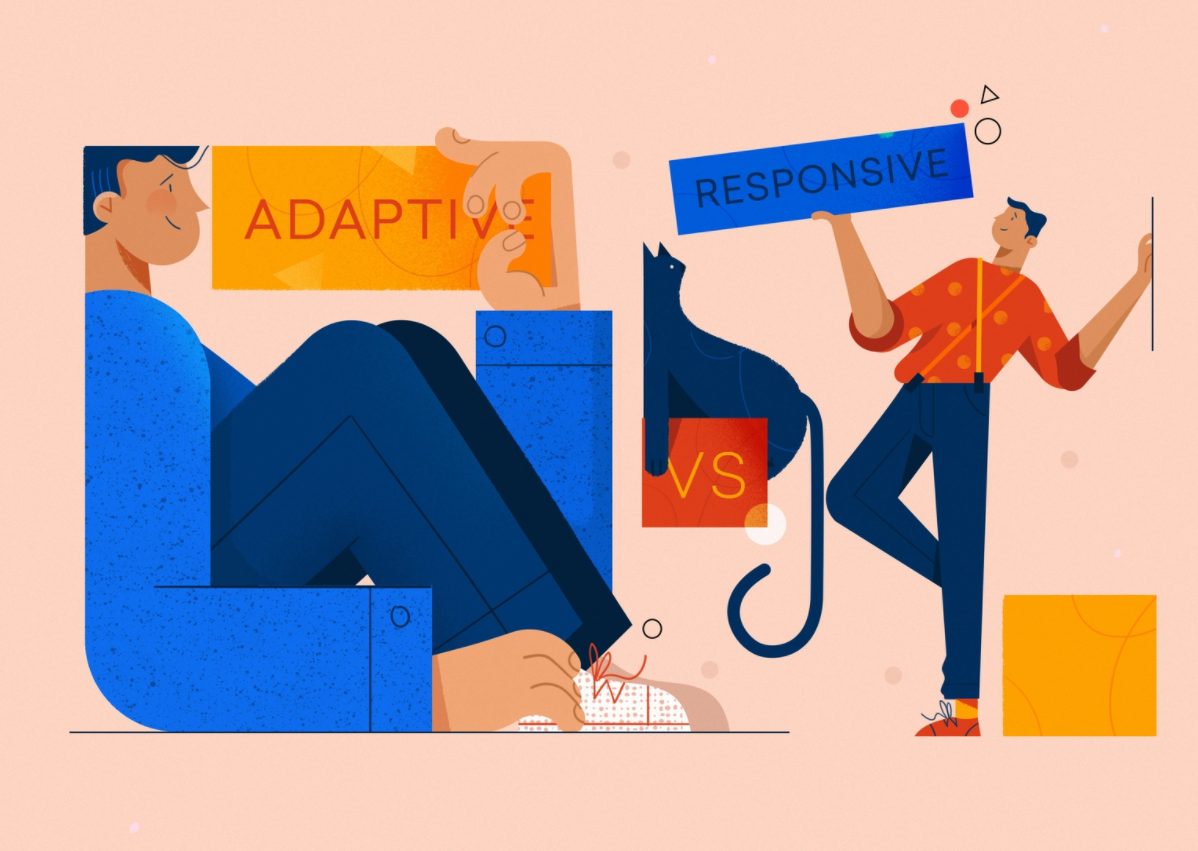The history of web design is something you’d better know if you’re working in this field. Moreover, it’s a fascinating and entertaining topic. Just think back to how sites used to look 10, 15, or even 30 years ago, and you will realize how quickly and dramatically web design has changed.
In this article, we’ll break down the origins of web design, give you a timeline of its evolution, and have a look at where the design stands in 2022. That’s a topic close to our hearts. At a digital product design company Fireart, we create web design, product, and application design solutions, so the ins and outs of how to provide an excellent UX experience are something we know like a book.

The birth of web design
The concept of the Internet, or the World Wide Web, first appeared in the 1940s in a book by Murray Leinster. The Internet we know today dates back to the 1980s. Who invented it? There is no way to tell, as there were a series of developments in computing built upon each other.
Early sites in the 1980s consisted of texts simply arranged on a black screen. They looked very basic because the main focus was on sharing information. Due to the black background, those sites were also incredibly dark, and that’s why we often call this period ‘the dark ages.’
However, the first example of web design came into being only in 1989, when Tim Berners-Lee, a physicist from CERN, created the first web server, a browser, and a web page. In 1989 and 1990, he proposed to create a World Wide Web of connected computer networks and was met with enthusiasm and curiosity.
The appearance of the first website, with its basic implementation, is the moment of web design’s birth.
Timeline of web design history
We will now give you a basic rundown of key moments in the history of web design.
1989
- Tim Berners-Lee creates the first browser, WorldWideWeb, based on principles he developed in 1989. He launches the browser in 1990.
1990
- Three university students: Alan Emtage, Peter Deutsch, and Bill Heelen, create the first search engine, Archie. It allowed users to search for files on the database. Quite a turning point in the internet’s history!
- This same year, the first release of the famous graphic editor Adobe Photoshop appeared on the market. After dozens of later versions, it’s still widely used today for web design and more. However, at the start Photoshop was only available for Macintosh computers and required a whole 2 MB of RAM (a lot for that time).
1991
- Berners-Lee launches the world’s first website using HTML commands. His early webpage had modest formatting: it was a white page with black text. Nevertheless, many of the core principles behind this page, like heading commands, are still fundamental to modern-day designers. In fact, this very article uses HTML in its design!
- HTTP, the first protocol designed to exchange hypertext documents between the server and browser, is also a creation of Berners-Lee. Could you imagine a modern website without hyperlinks? Now you know where they originate from.
1992
- This year’s notable development is Pei-Yuan Wei’s ViolaWWW browser, which he made when working at the University of California. This browser supported scripting, table rendering, and forms and contained a stylesheet to define the site’s visual appearance.
- Bare Bones Software releases BBEdit HTML and text editor for Macintosh to help web developers.
- Silvano De Gennar, a CERN scientist, uploads the first image to the web, a photo of a parody music group Les Horribles Cernettes.
- Later this year, another search engine appears. It’s Veronica, short for ‘Very Easy Rodent-Oriented Net-wide Index to Computer Archives.’
1993
- This year brings us Mosaic, one of the first web browsers with an image interface. It was free and usable on all platforms.
- ALIWEB(Archie Like Indexing for the Web) is another search engine from1993. That was a major step in terms of design, as it used color to draw the users’ attention to the best pages the web had to offer.
- Another significant milestone in web design from this year is the first landing page. Who made it? MTV, the music video channel. Their own Video Journalist Adam Curry ran the page, and it had bright, colorful images and looked worlds away from sites made just two years before.
1994
- This year that changes the web forever. In 1994 the first banner ad appears on the Hotwire site (now Wired). This site had a colorful yet minimal design, and the ad read: “Have you ever clicked your mouse right here? You will”.
- Also, this year, an HTML validator emerges, helping countless developers and designers.
- Once again, Berners-Lee makes a list. He creates the World Wide Web Consortium to establish rules for the web. This organization is responsible for HTML, CSS, XHML and XML standards.
- However, the most important development of this year is the creation of the Comic Sans font, based, as you can guess, on comics. This font is notorious and often mocked, but it’s also praised for its easy-to-read nature and recommended for teaching people with dyslexia.
1995
- This is the year of the creation of the high-performing full-text search engine ALTAVISTA. Eventually, Yahoo! bought ALTAVISTA, but they discontinued it in 2013 due to Google’s prominence.
- Also, in 1995, Brendan Eich invents JavaScript, intended for the browser Netscape 2 to provide a more dynamic interface. JavaScript allows for more interaction with the user so that websites can detect the user’s moves, such as changing the cursor position or pressing buttons, and respond to them as the designers want. That wasn’t possible before.
- We also see the launch of HTML 2.0, which gave developers the ability to create tables, forms, graphics, and more!
- The term user experience comes into existence at a conference in Denver, Colorado.
1996
- Håkon Wium Lie launches CSS, providing developers with the ability to edit and design pages easily. That allowed for the table-based design to be much more user-friendly and attractive. Microsoft Internet Explorer 3 supported CSS and made it a mainstream part of web design.
- The first appearance of Flash! Macromedia Flash 1.0 enables users to create vector animations. That would have significant ramifications for the late 1990s internet.
Flash allowed for the integration of animations and audio. However, people needed the correct Flash plugins to operate these features without mistakes. Nonetheless, these animations and GIFs became a mainstay of websites up until today, even though Flash is no longer as relevant.
1997-1998
Many technologies and sites in this period made huge impacts on the evolution of web design, but the most important ones are:
- Dreamweaver, GoLive, and other software make the website design more accessible to non-technical people. As a result, web design became an increasingly popular skill and career.
- Macromedia Fireworks allows designers to work with vector and bitmap graphics.
- Google emerges, later becoming the global mainstay that we all know. It was based on an algorithm to determine relevance to the end-user — a significant step in the SEO world.
2000-2004
- Website usage increases; there are an estimated 36 million internet users. Many well-known sites, such as Deviant Art, Google, Yahoo!, WordPress, Wikipedia, and PayPal, appear during this period. Many websites of the early era had gone, but web design became stronger, and internet usage and design became rapidly more mainstream.
- Content management systems come to prominence, allowing for the control of content on sites.
- Social media starts to emerge, with Yourspace, eventually Myspace in 2004 to solidify social media’s place in the world. Myspace introduced coding practices to a generation and set the tone for maximalist design practices. In comparison, modern pages have moved away from this style, the image and GIF-heavy pages that were so popular at the time influence people till today.
- The term Web 2.0, first used in 1998, becomes widespread. It emphasized social media, forums, and image sharing. Sites moved away from early HTML and became easier to access.
2004-2007
- Users can finally make websites without knowledge of HTML or other coding practices.
- Flickr, Reddit, YouTube, and eventually The Facebook (later Facebook, and now Meta) have become well-known names and sites. The internet of today is very much a direct result of this period.
2007-2013
- The rise of the smartphone, particularly the iPhone, provokes significant changes. There was a move towards mobile application design and cross-platform support. Flash was no longer compatible with Apple, and designers began to move away from using it.
- Around 2010 responsive design becomes essential for web designers. It lets designers and developers create sites that adjust and scale accordingly, regardless of the site or app’s intended device. Now it’s a must-have in all design processes.
- In 2013 React comes into existence. This open-source library made it easier to create user interfaces and UI components for web applications.
2013-2021
- HTML and CSS are still widespread in website design in this period, but there are more options for site development, depending on the result. JavaScript, HTML, CSS, etc., have their own advantages and disadvantages. So, designers had to pick specific languages and frameworks to specialize in.
- CSS based design is crucial for designers that look for engaging and attractive content, while the fundamentals of HTML are also of high importance. JavaScript is the foundation of many popular mobile applications, as Facebook developed React Native, a framework allowing for cross-platform development of applications.
- Flash becomes redundant in 2017. By this period, W3C (the consortium for the World Wide Web) finalized the rules for HTML 5.0, providing more flexibility and multimedia support to web designers.
- By 2019, mobile internet usage is more prominent than computers. It further shifts the importance of mobile application design.
Web Design in 2022
- In 2022, JavaScript runs many of your favorite apps and sites. Most applications aim toward minimalistic design, but many retro fonts are making a comeback.
- As you may have noticed, websites transform as you scroll. Many sites focus on one large landing page for a seamless transition between separate information and media. This is because many websites aim to look like apps as much as possible, to be multi-platform.
- Aesthetically, multi-sized fonts, abstract illustrations, art deco, and retro-futuristic styles dominate. You can read more about trends in web design here.
Conclusion
We hope you enjoyed learning about the history of web design. It’s truly astonishing seeing the evolution of web design over a relatively short period. The internet and design have radically changed compared to the early days.
As web design is always changing, it is crucial to stay up to date with all these trends when you want to design and develop your own site. Fireart can assist you in this by designing and developing your websites, applications, and more. Take a look at our services and hire dedicated designer to see how we can help you create a cutting-edge site or application.





















